ISSN: 2511-7602
Journal for Art Market Studies
ISSN: 2511-7602
Journal for Art Market Studies
Ai Fukunaga
The Hon. Henry Marsham (1845-1908) was a British businessman who collected Japanese works of art in Kyoto during the 1900s. His Kyoto ware collection at Maidstone Museum, Kent, is superior in both quantity and quality to other collections in Japan and overseas. The over 700 Japanese ceramic works in this collection range from daily dishes and tea vessels to utensils exclusively made for noble families. Marsham assembled the objects in a transnational process which was instigated in Japan before it continued in Britain. He collected Japanese works with local support before sending his collection to the Kentish provincial museum, with which he communicated closely on matters of arrangement and display. This paper examines the role of the Miyako Hotel, as an actor in creating Marsham’s collection as well as his Kyoto network for collecting. The interactions between the British collector and the local agents are illustrated based on letters and manuscript notes in his archive at the Maidstone Museum. The actors from the empirical study are then discussed in the context of Kyoto and the emerging tourist industry in the late Meiji era, complemented by the research of local newspaper articles of the time. Understanding collecting as a collaborative process by actors in different sectors, the network of collecting is contextualised here for both the collector and the people in Meiji Kyoto.
The Hon. Henry Marsham (1845-1908) was the third son of the Earl of Romney and a businessman who collected Japanese works of art during the 1900s while residing in the Miyako Hotel, Kyoto, a Western-style grand hotel built in the Meiji era (1868-1912). His Japanese ceramic collection at Maidstone Museum, Kent, is superior in both quantity and quality of its Kyoto ware to other collections in Japan and overseas. The collection demonstrates the rich history and diversity of Japanese ceramics for domestic use from the sixteenth to the nineteenth century, containing works made by artists with few surviving works and records as well as renowned potters of the late Edo period such as Aoki Mokubei (1767-1833) and Nin’ami Dōhachi (1783-1855).1 The over 700 ceramic works in this collection range from utilitarian dishes and tea vessels to utensils exclusively made for noble families. Among all the ceramics in the collection, the main focus of Marsham’s interest was Iwakurasan ware produced in Awata district in Kyoto during the eighteenth to mid-nineteenth centuries (fig.1). This article explores the formation of a collection of what will be referred to here as “Japanese art”. The word “art” is adopted in the sense of a wider concept of material culture, including craft and decorative art.
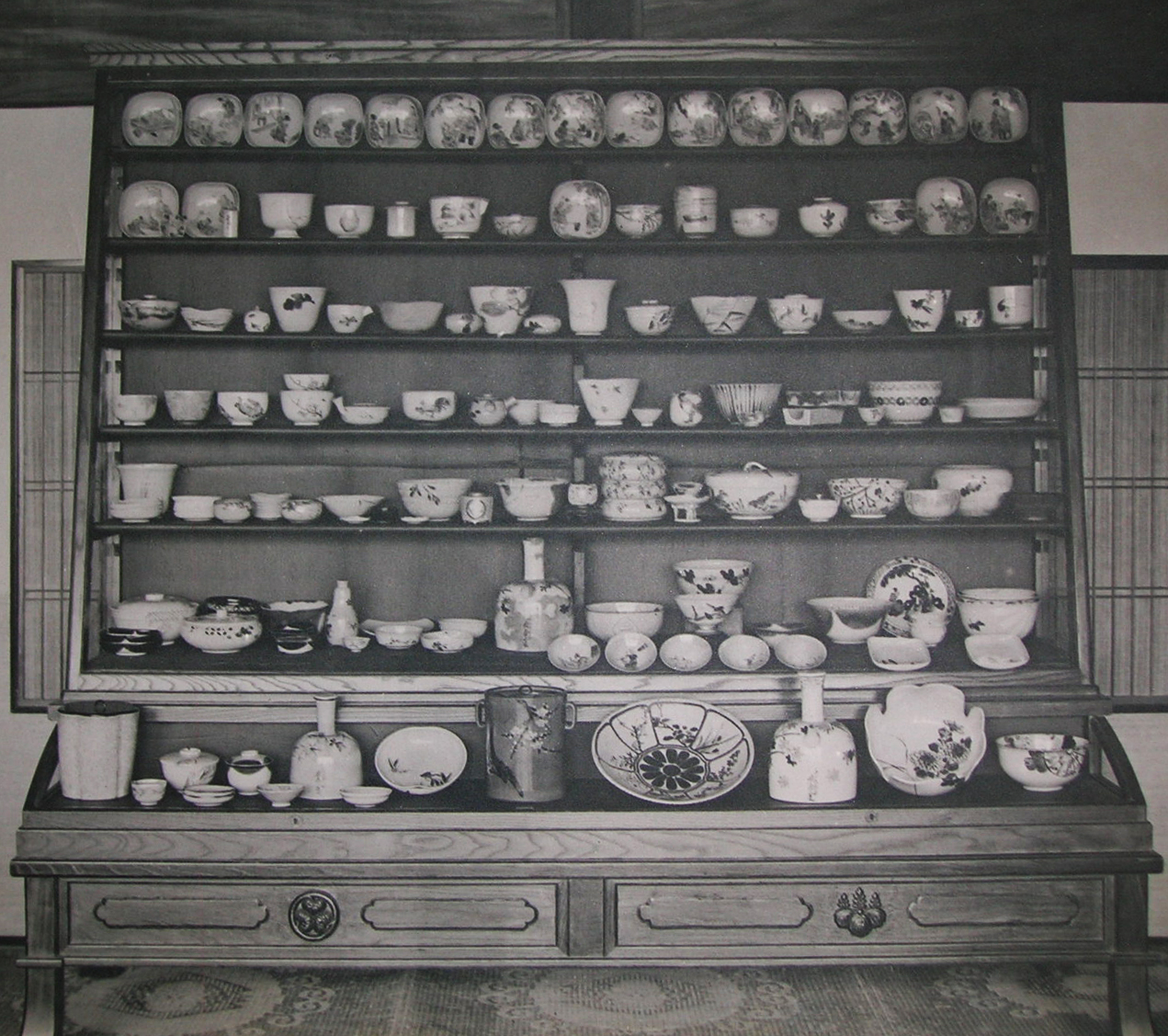
Fig.1: Wooden shelf with crests of hollyhock and chrysanthemum containing Iwakurasan wares, circa 1907
Maidstone Museum, Kent, U.K. © Maidstone Museums.
Marsham assembled the objects in a transnational process which was instigated in Japan before it continued in Britain. He collected Japanese works with local support before sending his collection to the Kentish provincial museum, with which he communicated closely on matters of arrangement and display. This paper examines the role of the Miyako Hotel as an actor in creating Marsham’s collection, as well as his Kyoto network for collecting. The interactions between the British collector and local agents are illustrated based on letters and manuscript notes in his archive at the Maidstone Museum. The actors from the empirical study are then discussed in the context of Kyoto and the emerging tourist industry in the late Meiji era, complemented by the research of local newspaper articles of the time. Understanding collecting as a collaborative process by actors in different sectors, the network of collecting is contextualised here for both the collector and the people in Meiji Kyoto.
“Japanese art” collected from Meiji Japan could include a much wider range of object categories than Western collections of Western art. During the Meiji era, Japanese objects from daily utensils to religious statues were shipped and brought to foreign countries as products, curios, souvenirs, antiques or arts and crafts. In museums overseas, Japanese collections were frequently either categorised as Art or Ethnographic collections.2 For example, the Victoria and Albert Museum in London exhibits Japanese crafts as art and design, while the Pitt Rivers Museum in Oxford displays them as anthropological collections.3 However, the boundary between the two categories is fluid. Moreover, the diverse range in the choice of collected pieces suggests that such categorical concepts did not always matter to those who collected Japanese works. Private collectors decided what to collect unrestricted from institutional frameworks to classify material cultures. Therefore, the market for this “art” needs to be observed through multiple channels of interaction between Japanese and foreign actors, regardless of their attitude towards objects as “art” or not.
Major approaches to collection studies, such as biographical research on collectors or macroscopic analysis of the European market, tend to neglect agents in the source country of objects and the role of locations as agents. Indeed, the role of some Japanese dealers in Paris, such as Hayashi Tadamasa (1853–1906) has been recognised and linked to the aesthetic fashion for all things Japanese or Japonisme during the 1860s to 90s.4 The Meiji governmental policies for International Exhibitions and supporting the export industry are another major topic of Japanese arts and crafts in industrial development, diplomacy, and culture.5 However, both approaches do not address the actors engaged locally in the collection of Japanese objects in Japan. In contrast to the decline of Japonisme in Western countries after the turn of the twentieth century, the number of foreign tourists to Japan increased and some visitors collected Japanese objects as Marsham did. According to the statistics by the Osaka Customhouse, foreign visitors spent 1,074,000 to 1,075,000 yen during March and April 1903. Over 90% of the expenditure was for souvenir consumption. Among them, textiles were the most popular with 300,000 yen spent, followed by metalware, ceramics and “antiques” with 200,000 yen spent respectively.6
The uneven narrative of the Japanese art market during the Meiji era is partly owed to a lack of source material on the Japanese domestic market for foreigners. Details on individual private dealers’ activities and sales are rarely published. Moreover, there is a gap in periods of interest on the Japanese side. In Japan, provenance research is more focused on Japanese collections after the Taisho era (1912-1926), when many auctions took place, followed by drastic changes for the owners of masterpieces.7
However, scholarly research in the past decade has rapidly advanced an understanding of the Japanese market. Research on travel in Japan explored another side of Japanese art in the Meiji era, as demonstrated by Ting Chang and Christine Guth.8 The methodology of looking at the experience of collecting while travelling provides a strong counterpart to the study of international events, national policies and aesthetic fashion. Furthermore, research on native agents has been developed by types of articles and locations. Monika Bansik investigated Japanese lacquerware merchants in the Meiji era as part of her analysis of European collecting of Japanese lacquerware.9 Nishii Akane analysed structure and content of the trade in Japanese crafts of the 1870s by Japanese middlemen and direct traders in Yokohama.10 Yamamoto Masako discussed the history of art dealers in Kyoto from pre-modern to the Meiji era.11 Ota Tomoki argued that the Kyoto market for foreigners dealt in high profile Japanese works and was supported by artists, dealers and the local community, including hotels.12 This article will contribute to the study of travelling and collecting in the late Meiji era by developing the analysis of native actors, particularly a hotel in Kyoto.
The Miyako Hotel has been one of the important Western-style grand hotels in the city of Kyoto since 1900. It was built as the third of this kind in Kyoto following the Ya’ami Hotel and the Tokiwa Hotel.13 Although the owner company of the Miyako Hotel changed over time, it has been welcoming guests for over a century.14 Apart from being a place of accommodation, the Miyako Hotel embodied multiple functions from early on. In 1890 (Meiji 23), the predecessor of the hotel developed as a new landmark on a hill transformed from one of the rural landscapes in Kyoto, which had been developed as a park called Yoshimizuen. The beautiful view of and from the park attracted the locals.15 In 1895, Tomioka Tessai (1837-1924), artist and Confucian scholar, enjoyed a visit to the park with his friend the painter Taniguchi Kōkyō (1864-1915). Following the East Asian tradition of appreciating eight beautiful scenes of specific locations as a theme of paintings, which originated from the Eight Views of Xiaoxiang, in the Chinese Henan province, Tessai selected eight views of Yoshimizuen.16 Subsequently, Yoshimizuen became a meisho or landmark in Meiji Kyoto. Moreover, the garden was not only a venue for visiting but also for cultural and social gatherings, from composing poems to wedding parties.17
The function of the Hotel as a social complex also worked for foreign guests in the 1900s. The hotel provided a diplomatic platform and a venue for networking, both with other foreigners and locals. The Anglo-Japanese Alliance concluded in 1902 brought important visitors from Britain to Japan. Many of them stayed in grand hotels in Kyoto. When Prince Arthur of Connaught (1883-1938) visited Japan in the same year to award the Order of the Garter to the Meiji Emperor in Tokyo, he also came to Kyoto and stayed in the Miyako Hotel.18 Beside the British, Germans and Americans were the other main nationalities among the guests at the Hotel.19 According to the records of the Miyako Hotel, foreign guests, local politicians, entrepreneurs as well as dealers participated at events in the hotel, such as the annual Christmas party hosted from 1901.20
For the Hon. Henry Marsham, the Hotel acted as a base for his life in Japan as well as for collecting Japanese ceramics. Marsham’s archive at Maidstone Museum contains 21 letters from the collector to J.H. Allchin, the then curator of the Museum, dated from 1882 to 1908. Among them, ten letters written during 1905 and 1908 bear the header of the Miyako Hotel, Kyoto, where the collector spent much of his time. The Hotel was more than an accommodation for the collector. Marsham’s gorgeously decorated album of his travel photography held at the Museum demonstrates the close relationship of the collector with the Hotel. The album shows not only the panoramic view of Kyoto seen from the Hotel (fig.2) but also formal photographs of Nishimura Nihei, the owner of the Hotel (fig.3) and even his son.

Fig.2: Panoramic view from Miyako Hotel, Kyoto, from Hon. Henry Marsham’s album of travel photography, circa 1907-8
Maidstone Museum, Kent © Maidstone Museums.
At the Hotel, Japanese objects were exhibited and sold, and information on objects was brought in by Japanese local agents. The hotel worked as a satellite marketplace for dealers. According to Miyako hoteru hyakunenshi, an official book of the company’s history, there was a gallery run by dealers in Kyoto to showcase their articles within the building of the Hotel.21 Marsham was in close contact with a Kyoto dealer, Hayashi Shinsuke, who sold Japanese ceramics to the collector and kept the collection at his shop while Marsham was staying in Kyoto (fig.4).22 It is uncertain if Hayashi had his own booth in the building. However, in the Meiji era, Kyoto dealers freely visited guest rooms in hotels and sold their articles to foreign visitors.23 The seamless connection between the accommodation and dealers’ economic activity was pivotal in facilitating Marsham’s intensive collecting in Kyoto. Moreover, Marsham’s guide at the Miyako Hotel acted as his assistant for collecting. Henry’s sister Anne Marsham wrote to Allchin that Mr Hirooka who worked for the Miyako Hotel significantly contributed to Marsham’s collecting by finding “specimens of rare kinds”.24 It is also known that interpreters and guides for foreign guests played an important role in bridging the gap between hotels and dealers, often with the benefit of a dealers’ rebate.25 Although details about Mr Hirooka are unknown, his cooperation with Marsham’s collecting activities appears to be established by the unique economical environment at the Hotel.
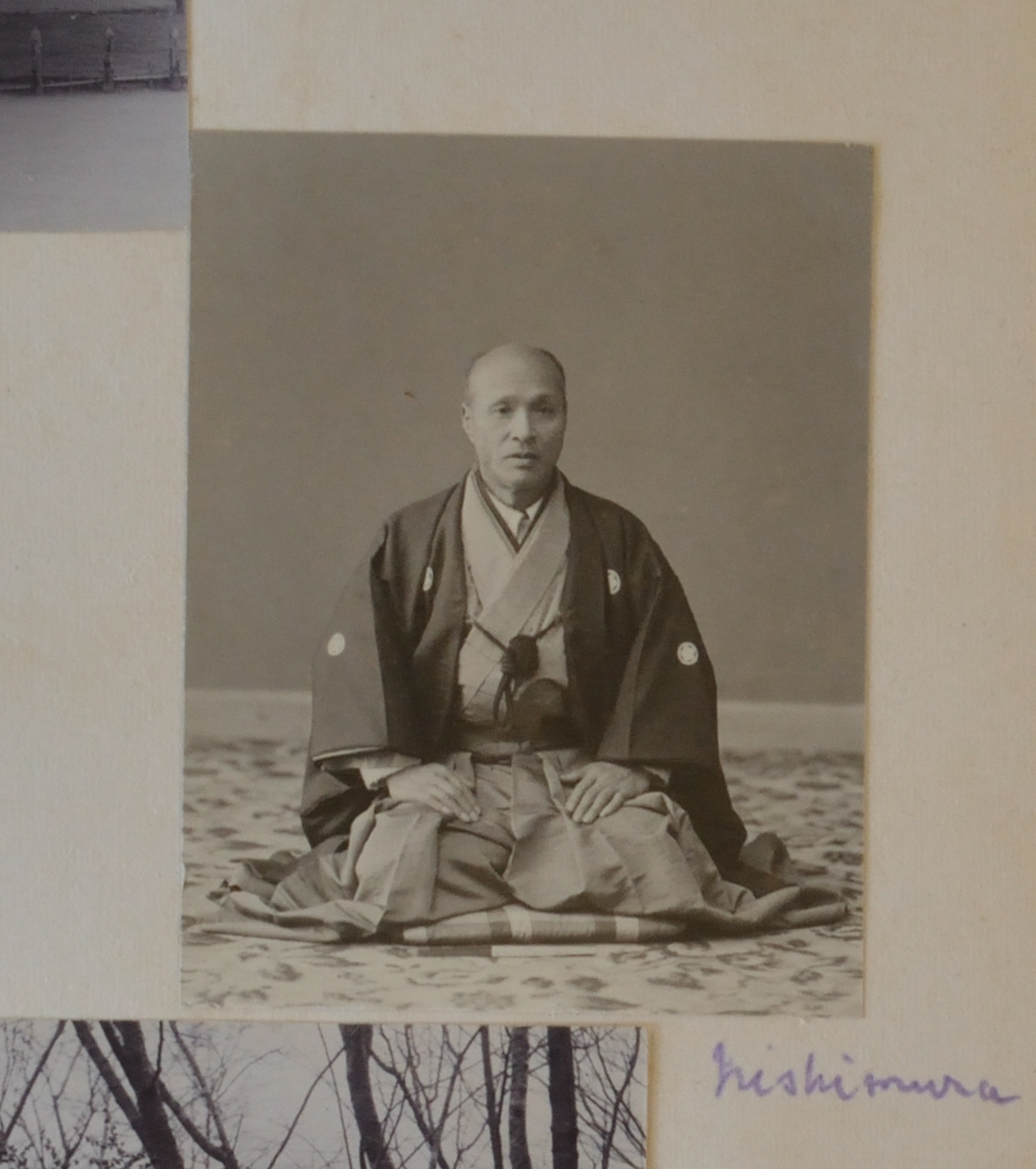
Fig. 3: Portrait of Nishimura Nihei, owner of Miyako Hotel, Kyoto, from Hon. Henry Marsham’s album of travel photography, circa 1907-8
Maidstone Museum, Kent © Maidstone Museums.
Local residents were also involved in Marsham’s collecting. The local newspaper Kyoto Hinode Shimbun referred to Marsham on 1 July 1906 as a “British noble staying in the Miyako Hotel, who researches the development of Japanese ceramics” and “already collected over 800 pieces”. This newspaper article transformed the collector into a public figure and thus enabled Kyoto locals to contact him directly by addressing correspondence to the Hotel. For example, Kawakami Yūjirō, a soy sauce merchant in Kyoto wrote to Marsham offering to gift his incense containers inherited from his family.26 Kawakami knew about Marsham from a newspaper article and suggested to the collector that “the ceramics must feel happy if they are possessed by a person who appreciates the beauty and I don’t have such taste.”27
Furthermore, the Hotel was even a place to create works of art. The Marsham collection at the Maidstone Museum holds a teapot made by Hōzan Shōhei (1844-1937), a Kyoto potter whose workshop had a historical connection to the Awata district, where the Hotel is located (fig. 5).28 The lid of the teapot has an inscription on the inside stating that it was made with the clay from the grounds of the Miyako Hotel (fig. 6). In Marsham’s hand-written list of his collection, he noted that the teapot was “made of clay I picked up from heap [at] Miyako hotel garden” in 1908, the final year of his stay in Japan.29 The making of a ceramic work with such a direct connection to a garden reminds us of the practice of Edo-period daimyo nobles whose enthusiasm for ceramics led them to have kilns built within their castles where utensils could be ordered to suit their taste. Their final products are called oniwa-yaki or garden ware. This teapot may have been a potter’s gift to Marsham when the latter was about to leave Japan. The hotel functioned as a memorial place for the collector, strengthening his ties with the locals.
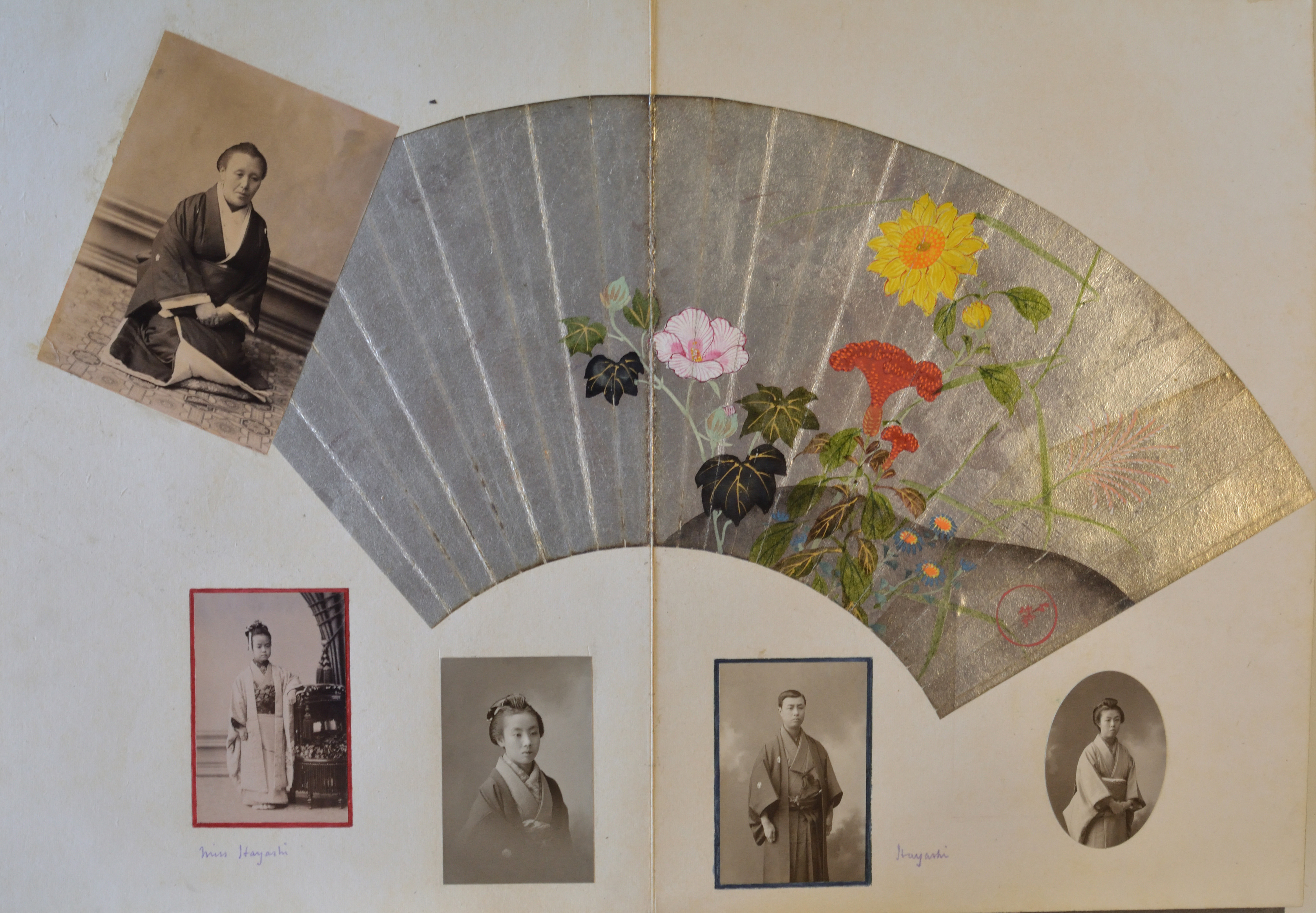
Fig. 4: Portraits of Hayashi family with a painting of flowers on a fan, Kyoto, from Hon. Henry Marsham’s album of travel photography, circa 1907-8
Maidstone Museum, Kent © Maidstone Museums.
The functions of the Miyako Hotel were not confined to within the hotel. The Hotel was an essential element of foreign guest hosting that was packaged with tourism. The Hotel was a start and end point for travel in Kyoto. When Admiral Sir Arthur William Moore (1847-1934) visited Japan for his diplomatic mission, Marsham welcomed him at the Miyako Hotel and they started sightseeing and visiting antique shops in Kyoto under the guidance of Mr Hirooka.30 Marsham’s connections acquired through his stay in the Hotel enabled him to become a mediator in guiding foreign guests to local dealers.
The close relationship of the Hon. Henry Marsham with the Miyako Hotel was enabled by the development of modern tourism in Japan and the urban development of Kyoto. Within a socioeconomic structure answering the needs of both foreign visitors and locals, the role of hotels expanded throughout the Meiji era.
Modern Japanese tourism, in which hotels played pivotal roles, developed through both external and domestic forces. From the 1860s, Western-style hotels were built by foreigners and Japanese in Edo and the Yokohama area. In 1868 (Keiō 4), the first hotel planned and managed by the Japanese began with Tsukiji Hoterukan in Edo, reflecting the accommodation needs of foreign officials and visitors to Japan.31 Besides its architecture designed by an American, Richard Perkins Bridgens (1819-1891), the hotel provided guests with service in Western style. Simultaneously, it was arranged with Japanese elements that were attractive to foreigners such as namako-kabe, walls with diagonally installed tiles with plaster between the tiles, and blossoming cherry and pine trees in the garden.32 From the beginning of its history, Japanese hotels were expected to display dual cultures, which were shown selectively according to what the guests wanted to experience.
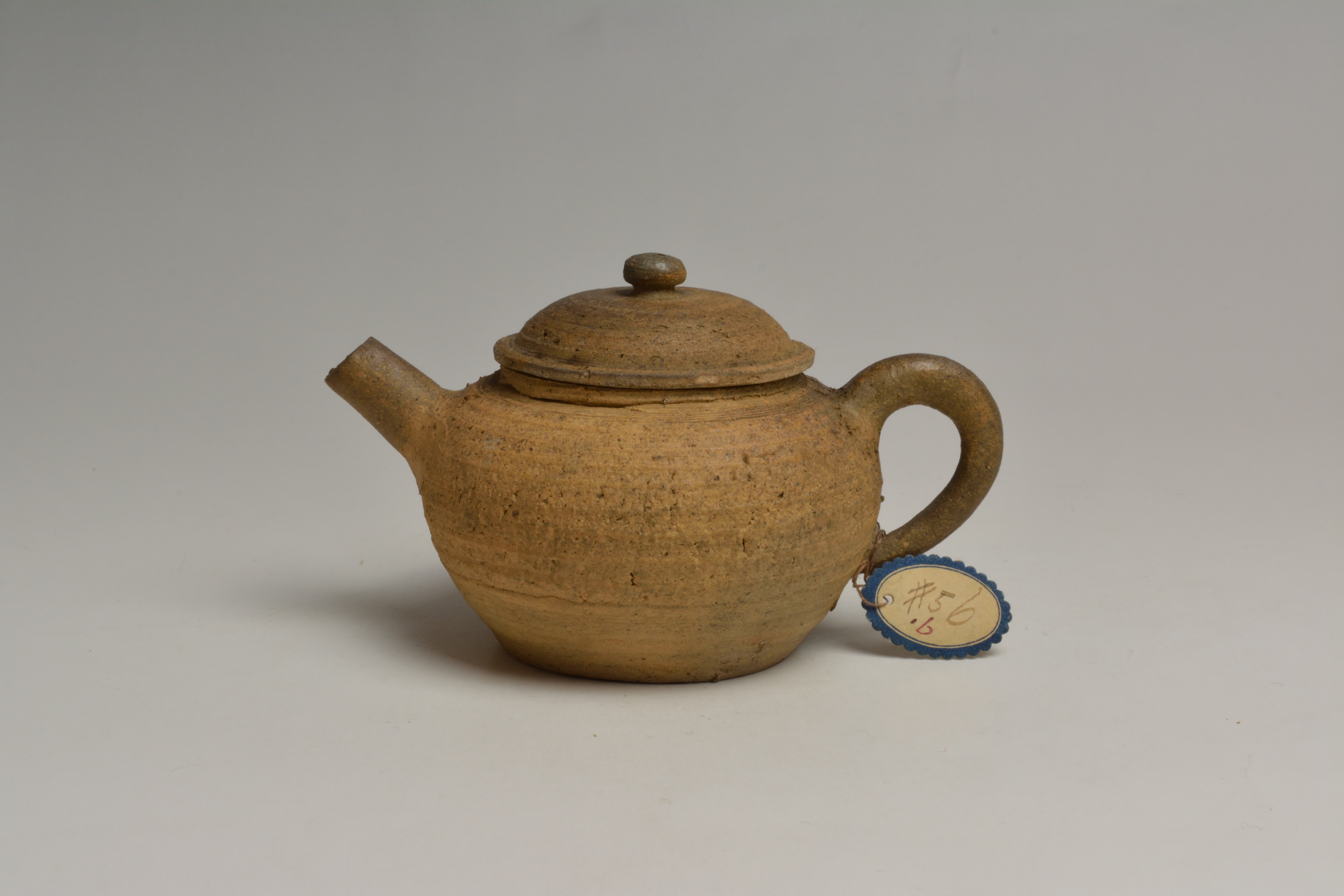
Fig. 5: Hōzan Shōhei (1844-1937)
Teapot, 1908, stoneware, 6.0 cm x 11.0 cm
Marsham collection number 56(6)
Maidstone Museum, Kent © Maidstone Museums.
From the 1870s, other regions as well as Kyoto constructed modern facilities as resort hotels. The gradual loosening of regulations on foreigners’ mobility in Japan increased the demand for accommodation. Formally, until the 1890s, it was prohibited for foreigners to travel outside 10 ri or 43,200 yards from treaty ports. However, privileged foreigners such as diplomats and employees of the Japanese government were allowed to travel when the destination met certain conditions, such as commuting, academic research and a retreat for health.33 In July 1899, the travel ban was lifted. This corresponds to the abolishment of the system of foreign settlements in Japan where foreigners were previously contained to live and work.34
Many Japanese regions could hope to benefit from the newly relaxed policy on foreigners’ mobility. Kyoto played a leading role in increasing the number of foreign visitors to the area. In 1869, the Meiji restoration had relocated Japan’s capital from Kyoto to Tokyo. As the Meiji emperor and imperial families moved to Tokyo, Kyoto suffered fundamental cultural and economical losses because the tie with imperial households had supported the development of culture and industries.35 It was vital for Kyoto to boost the economy through urban development, which included the introduction of a canal, railways and exhibitions to attract visitors. In 1871, a private company founded by three merchants in Kyoto hosted the first Japanese hakurankai or exhibition, prior to other domestic exhibitions following the success of International Exhibitions overseas. The Kyoto exhibition was held annually afterwards. In 1872, foreigners were able to enter the old capital during the exhibition through requesting special permission.36 The first attempt at a Kyoto exhibition met with criticism describing it as merely an antique or curio show and failed to improve the local industry.37 However, the exhibition soon became a milestone in the development of the tourist industry in Kyoto, as both domestic and foreign visitors were considered important actors in the revitalisation of the city.
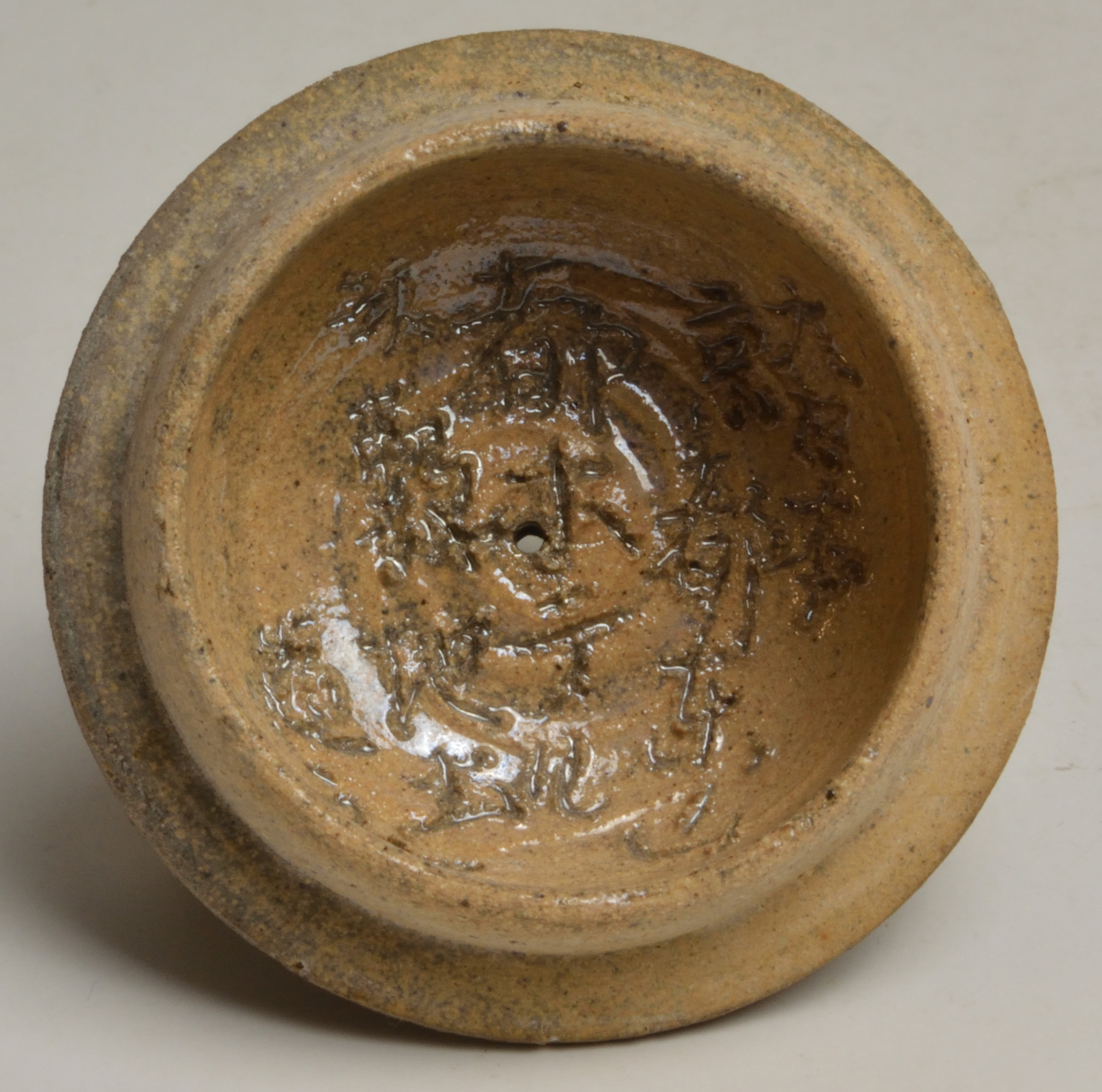
Fig. 6: Hōzan Shōhei (1844-1937)
Lid of teapot, 1908, stoneware
Marsham collection number 56(6)
Maidstone Museum, Kent
© Maidstone Museums.
The increasing number of tourists in Kyoto raised awareness of the significance of hotels, as core venues for tourism as well as the local economy. When Ya’ami Hotel, one of the important Western-style hotels in Kyoto burned down in 1906, there was a debate whether the private hotel should be run by the local government, based on the economic impact the enterprise had on the public of Kyoto. On 8 May 1906, the local newspaper Kyoto Hinode Shimbun published an editorial entitled “Hoteru shiei ron [Opinion of running a hotel by the city]” heading the front page. The writer argued that the lack of a hotel was the cause of the unsatisfactory number of foreign visitors and continues:
...All foreign visitors to our country once visit Kyoto. It is not too much to say that Kyoto is the centre of kyaku shōbai shugi [guest business purpose]. Thus, it is essential to establish facilities focusing service industry here to satisfy many foreign guests. Above all, building a perfect hotel is the matter of urgency. ... Especially, a hotel is not only a profitable business but also a type of public enterprise. More foreigners’ visit to Kyoto directly or indirectly promotes urban prosperity in many areas. It is only possible to encourage this if the city runs a hotel.38
Although Kyoto city did not take up the management of a public hotel, the loss of a hotel revealed how essential it was to maintain the entire economic activity in Kyoto derived from tourism.
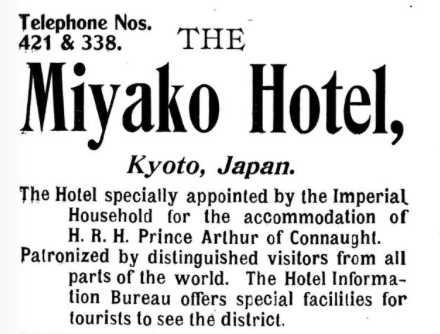
Fig.7: Advertisement of the Miyako Hotel, Kyoto, 1906
The Welcome Society of Japan, A guidebook for tourists in Japan, Tokyo: The Welcome Society of Japan, 1906
Princeton University, Public Domain Mark 1.0. http://books.google.com/books?id=dYxNAAAAYAAJ&hl=&source=gbs_api.
Furthermore, the late Meiji era embraced a horizontal network of tourism beyond regions. Some hotels expanded their role in supporting foreigners’ travels as an agent of Kihinkai or the Welcome Society of Japan. The Society was founded in 1893 by entrepreneurs, bureaucrats and politicians “to welcome foreign visitors to Japan, and render them all possible assistance during their sojourn”.39 The Society gave instructions in customer service to regional ryokan, Japanese-style inns, improved the quality of translators, and published guidebooks and maps for visitors.40 Even though the Society originated in Tokyo, it eventually acquired partners from different parts of Japan. The Miyako Hotel was also an actor on behalf of the Society, as it was one of two outlets in Kyoto selling the books published by the Society.41 These guidebooks advertised the Hotel to foreign visitors.42 When the Society dissolved in 1914 to make way for its successor, the Japan Tourist Bureau founded in 1912, the hotelier Nishimura Nihei was listed as one of the members who had contributed most to the Society.43
The Society’s activities had been motivated by the boom in overseas travels during the late nineteenth century, especially among the higher classes. The number of tourists to Japan grew steadily in correspondence with an increasing route network of steamships and the development of tour companies for overseas travel such as Thomas Cook.44 In addition, the founders of the Society were aware of the benefits of tourism to both the economy and diplomacy by learning from advanced countries in the tourist industry such as France and Switzerland.45 Importantly, unlike its successors, the Society implicitly targeted visitors from higher social classes. The Society often hosted welcoming parties for guests at restaurants and villas.46 Shirahata Yōzaburō argues that the Society intended to demonstrate Japanese progress to foreign dignitaries, which echoed Japanese diplomacy at the preparation stage of the Society in the 1880-90s under the foreign minister Marquis Inoue Kaoru (1836-1915).47 His diplomatic strategy included hosting social events for Western and Japanese guests in Western style at Rokumeikan or Deer Cry Pavilion in Tokyo, designed by a British architect, Josiah Conder (1852-1920), in order to negotiate the revision of unequal treaties with Western countries for Japan.48 Inoue’s policy was criticised for its radical Westernisation, and he failed to change the legal inequality between the West and Japan.
However, private venues maintained the approach to welcoming guests which was phased out from national policy. Noticeably, the Miyako Hotel took advantage of the stay of important guests at the Hotel for branding its image. In the advertisement for the Welcome Society’s guidebook, the Hotel mentioned their past guest Prince Arthur Connaught (fig. 7). The demonstrable high regard for noble families might have affected how the Hotel built its relationship with Marsham, who was described as “Eikoku kizoku [British noble]” rather than a businessman in the local newspapers of the time.49
In conclusion, the Miyako Hotel was an art market venue connected to the wider economic and diplomatic platform of Meiji Kyoto. The selling, gifting and creating of Japanese ceramics by the local actors to and for the Hon. Henry Marsham were direct and indirect forms of interactions through the Hotel, an institutional actor in the creation of Marsham’s collection. Backed by the developing regional tourist industry and Japanese tourism targeting travellers from a wealthier and educated class, a structure for assisting foreign guests was established. As a significant means of promoting Kyoto, which benefited the local citizens, the Hotel was able to connect a British collector of Japanese Art to residents in Kyoto.
This research was partially supported by the Meiji Jingu studentship for Japanese studies in the academic year of 2016/2017 and the Sainsbury Institute of Japanese Arts and Culture. I thank Dr Stacey Pierson, Dr Angus Lockyer and Dr Louise Tythacott, my supervisors, for their valuable guidance. I appreciate the support from Professor Oka Yoshiko and Professor Nicole Coolidge Rousmaniere for my survey. I am grateful for the cooperation with Maidstone Museum which made my research possible.
Ai Fukunaga is a PhD student at SOAS University of London. This article is based on the author’s ongoing research for her PhD project. The discussion on other local actors and their relationship to the Hotel and the collector will be developed in future publications.
Correction: An earlier version of this article incorrectly stated the founding year of the Miyako Hotel as 1902, not 1900. Also, the year when foreigners were able to enter Kyoto by special permission to see the exhibition was given as 1873. It is in fact 1872.
1 This article refers to Japanese names in Japanese publications in the order of family name followed by first name.
2 Monika Bincsik, European Collectors and Japanese Merchants of Lacquer in ‘Old Japan’. Collecting Japanese Lacquer Art in the Meiji Period (1868–1912), in Journal of the History of Collections, vol. 20, no. 2 (2008), 221-222. Bincsik discusses the framework in positioning Japanese lacquerware in Western collections between ethnography and applied art during the Meiji era.
3 “Japan”, Victoria and Albert Museum; https://www.vam.ac.uk/collections/japan [accessed 2 July 2018].”Pitt Rivers Museum”, Pitt Rivers Museum; https://www.prm.ox.ac.uk/ [accessed 2 July 2018].
4 Tokyo Kokuritsu Bunkazai Kenkyūjo, Correspondance Adressée à Hayashi Tadamasa (Tokyo: Kokusho Kankūkai, 2001). Max Put, Plunder and Pleasure: Japanese Art in the West 1860-1930 (Leiden: Hotei Pub, 2000), 89; Ting Chang, Travel, Collecting, and Museums of Asian Art in Nineteenth-Century Paris, The Histories of Material Culture and Collecting, 1700-1950 (Burlington, VT: Ashgate, 2013), 122-3.
5 Satō Dōshin, Meiji kokka to kindai bijutsu: bi no seijigaku (Tokyo: Yoshikawa Kōbunkan, 1999); Norota Jun’ichi, Bakumatsu Meiji no biishiki to bijutsu seisaku (Kyoto: Miyaobi Shuppansha, 2015).
6 Kimura Gorō, Nihon no hoteru sangyōshi (Tokyo: Kindai Bungeisha, 1994), 202-203. As the entry of “antique” is separated from other categories, it is reasonable to assume that the listed crafts are the contemporary products.
7 Otabe Yūji, Tokyo Bijutsu Kurabu kessei to bijutsu shijō, in Bijutsushō no hyakunen: Tokyo Bijutsu Kurabu Hyakunenshi [100 Year History of Japanese Art Dealers from 1907 to 2006], ed. by Tokyo Bijutsu Kurabu Hyakunenshi Hensan Iinkai (Tokyo: Tokyo Bijutsu Kurabu: Tokyo Bijutsushō Kyōdō Kumiai, 2006), 107–38.
8 Chang, Travel, Collecting, and Museums; Christine Guth, Longfellow’s Tattoos: Tourism, Collecting, and Japan (Seattle: University of Washington Press, 2004).
9 Bincsik, European Collectors and Japanese Merchants.
10 Nishii Akane, 1870 nendai no kōgei yushutsu: “Yokohama Maiichi Shimbun” 1873 nen kara 1879 nen no urikomiran, yushutsuran wo chūshin ni [Exports of Japanese Crafts in the 1870s, Seen through the Urikomi and Yushutsu Pages in the Yokohama Mainichi Shinbun]’, in Studies in Japonisme (2017), 23–45.
11 Yamamoto Masako, Karamonoya kara bijutsushō e: Kyōto ni okeru bijutsu shijō wo chūshin ni (Kyoto: Kōyō Shobō, 2010).
12 Ota Tomoki, Kindai Kyoto ni okeru bijutsu kōgeihin no “RaiKyo gaikokujin muke” yushutsu [The “Export” of Artistic Crafts to Foreigners Visiting Kyoto in the Modern Period], in Bijutsushi, vol. 59. no. 2 (2010), 407–23.
13 Kimura, Nihon no hoteru sangyōshi, 121, 129. Ya’ami Hotel started in 1881. The Tokiwa Hotel founded in 1888 was renamed as Kyoto Hotel in 1895.
14 Kimura, Nihon no hoteru sangyōshi, 146-7. Kintetsu Miyako Hotels International, ‘The Westin Miyako Kyoto’, https://www.miyakohotels.ne.jp/westinkyoto/english/ [accessed 10 May 2018].
15 Miyako Hoteru, Miyako Hoteru 100 nenshi (Kyoto: Miyako Hoteru, 1989), 1-3.
16 Miyako Hoteru, Miyako Hoteru 100 nenshi, 7.
17 Miyako Hoteru, Miyako Hoteru 100 nenshi, 5.
18 Miyako Hoteru, Miyako Hoteru 100 nenshi, 22. The Prince commemorated his visit by planting a pine tree in the garden of the Hotel, attended by the Army General Count Kuroki Tamemoto (1844-1923), and Marshal Admiral the Marquis Tōgō Heihachirō (1848-1934). Miyako Hoteru, Miyako Hoteru 100 nenshi, 25.
19 Miyako Hoteru, Miyako Hoteru 100 nenshi, 12.
20 Miyako Hoteru, Miyako Hoteru 100 nenshi, 18.
21 Miyako Hoteru, Miyako Hoteru 100 nenshi, 27. The dealers were then called bōekishō or trade dealers.
22 The Diaries of Sir Ernest Satow, British Envoy in Peking (1900-06), ed. Ian C. Ruxton (Morrisville, N.C.: Lulu Press, 2006), 20. Ota, ‘Kindai Kyoto ni okeru bijutsu kōgeihin no “RaiKyo gaikokujin muke” yushutsu’, 408. Ota points out that Hayashi Shinsuke was the first recorded dealer who sold antiques to foreign visitors in Meiji Kyoto.
23 Ota, ‘Kindai Kyoto ni okeru bijutsu kōgeihin no “RaiKyo gaikokujin muke” yushutsu’, 415.
24 Anne Marsham, an unpublished letter to J.H. Allchin, dated 1 March 1909, Maidstone Museum, Kent.
25 Ota, ‘Kindai Kyoto ni okeru bijutsu kōgeihin no “RaiKyo gaikokujin muke” yushutsu’, 415.
26 Kawakami Yūjirō, an unpublished letter to Marsham, dated 9 December 1907, Maidstone Museum, Kent.
27 Ibid. Kawakami provided no information about which newspaper article he had read.
28 The Hōzan family continues to the 20th generation in Kyoto. Unrin’in Hōzan, ‘Unrin’in Hōzan no rekishi to sakutō - Kyoto Awatayaki, Kyōyaki-’; http://hozan-ware.com/ [accessed 11 May 2018].
29 Hon. Henry Marsham, unpublished list of the Marsham collection, 1908, Maidstone Museum, Kent.
30 Mūa teitoku nyūrakus’, in Kyoto Hinode Shimbun, 1 July 1907.
31 A contemporary newspaper, The Far East refers to the Tsukiji Hoterukan as Yedo Hotel. Hatsuda Tōru, Gaikokujin ryokan (Tsukiji Hoterukan) no kenchiku ni tsuite, 331 (1983), 130.
32 Hatsuda, Gaikokujin ryokan no kenchiku ni tsuite, 135. ‘Tōto Tsukiji hoterukan no zu’ (Sahaijo, 1868), National Diet Library Digital Collections; http://dl.ndl.go.jp/info:ndljp/pid/1306090 [accessed 12 May 2018].
33 Shirahata Yōzaburō, ‘Ijin to gaikyaku’, in Jūkyū seiki Nihon no jōhō to shakai hendō, Kyōto Daigaku, ed., Jinbun Kagaku Kenkyūjo (Kyoto: Kyto daigaku jinbun kagaku kenkyūjo, 1985), 116.
34 Kimura, Nihon no hoteru sangyōshi, 48.
35 Namiki Seishi, ‘Kyoto no shoki hakurankai ni okeru “kobijutsu”’, in Maruyama Hiroshi, Iyori Tsutomu, and Takagi Hiroshi, eds., Kindai Kyoto kenkyū, (Kyoto: Shibunkaku shuppan, 2008), 326.
36 Itō Yukio, Kyōto no kindai to tennō: gosho wo meguru dentō to kakushin no toshi kūkan, 1868-1952 (Tokyo: Chikura shobō, 2010), 14-15.
37 Namiki, ‘Kyoto no shoki hakurankai ni okeru “kobijutsu”’, 328.
38 Hoteru shei ron, in Kyoto Hinode Shimbun, 8 May 1906. Translated by the author.
39 Welcome Society of Japan, ed., A Guide-Book for Tourists in Japan (5th edition, Tokyo: Welcome Society of Japan, 1910), i.
40 Kimura, Nihon no hoteru sangyōshi, 167-8.
41 Welcome Society of Japan, ed., Useful Notes and Itineraries for Travelling in Japan (Tokyo: Welcome Society of Japan, 1907); http://dl.ndl.go.jp/info:ndljp/pid/1085123 [accessed 4 May 2018].Welcome Society of Japan, A guide-book for tourists in Japan (5th edition).
42 Welcome Society of Japan, A Guide-Book for Tourists in Japan (2nd edition. Tokyo: Welcome Society of Japan, 1906); http://archive.org/details/bub_gb_dYxNAAAAYAAJ [accessed 8 April 2018], 128.
43 Kihinkai hombu, ed., Kihinkai kaisan hōkokusho (n.p.: Kihinkai, 1912), 1126, reproduced in Shibusawa Eiichi denki shiryō kankōkai ed., Shibusawa Eiichi denki shiryō, vol.36 (Tokyo: Ryūmonsha, 1961), 7; https://eiichi.shibusawa.or.jp/denkishiryo/digital/main/index.php?DK360001k_text [accessed 8 April 2018].
44 Maruyama Hiroshi, Kindai tsūrizumu no reimei: “naichi ryokō” wo megutte, in Jūkyū seiki Nihon no jōhō to shakai hendō, ed. by Kyōto Daigaku. Jinbun Kagaku Kenkyūjo. (Kyōto: Kyōto Daigaku Jinbun Kagaku Kenkyūjo, 1985), 89.
45 Kimura, Nihon no hoteru sangyōshi, 164.
46 Kimura, Nihon no hoteru sangyōshi, 167.
47 Shirahata, Ijin to gaikyaku, 121, 126.
48 Toshio Watanabe, Josiah Conder’s Rokumeikan: Architecture and National Representation in Meiji Japan, in Art Journal (1996), 21.
49 For example, Miyako Hoteru, Miyako Hoteru 100 nenshi, 18. ‘Mūa teitoku nyūrakusu’, in Kyoto Hinode Shimbun, 1 July 1907.